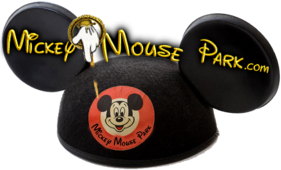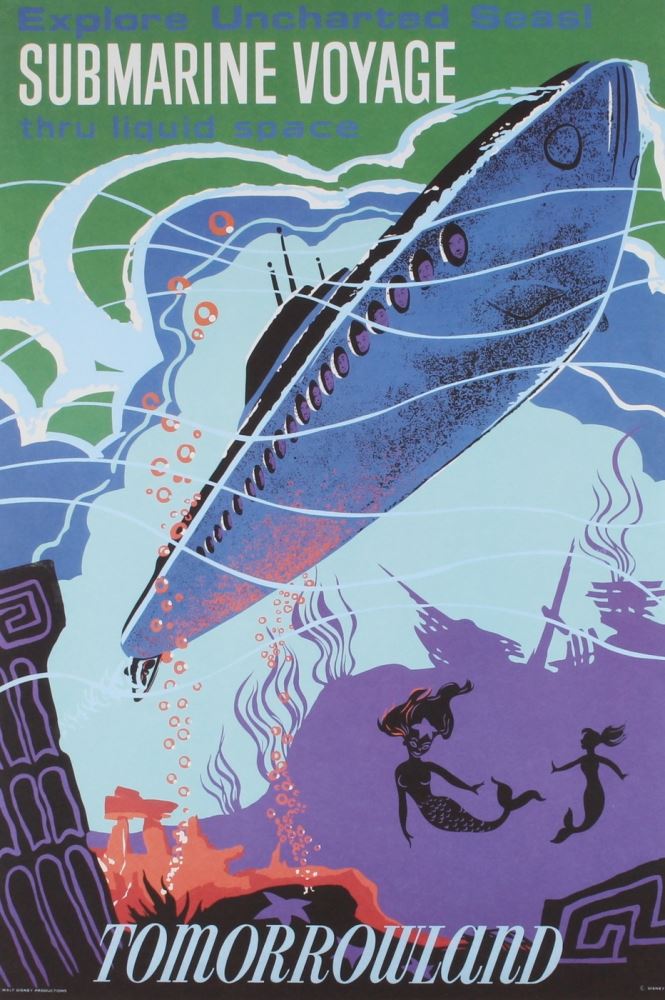
Technically speaking they weren't submarines. Yes. They look like real subs were named after real Navy subs were promoted as the world's largest peacetime fleet of subs and were sponsored by a company General Dynamics that actually built subs, but if the true definition of a submarine is a vessel completely submerged beneath the water surface, then what began circling in Disneyland's 9 million gallon concrete lagoon in June of 1959 were not true submarines For decades eager crowds swarmed the attraction that cost 2 and 1/2 million dollars (almost $26 million in 2022 dollars) to build and that even featured live mermaids in its lagoon for a couple years whether nosing out from under a waterfall or sliding gracefully through illuminated evening waters the submarines made vivid postcard objects. A sub streaking through the depths underwater was transformed into one of Disneyland's most dramatic
action posters.
The sub queue ran underneath the Monorail station making this a particularly bustling area after paying with their "E" ticket guests boarded a sub and descended through a hatch to sit in front of small portholes for a 9-minute voyage. Realistic shipboard sounds and bubbles streaming past the windows recreated a descent into liquid space and as each sub putted along at just under two miles an hour. Such memorable sights as the exotic mechanical fish. The ruins of Atlantis tethered artificial mermaids sunken treasure to polar ice cap and a googly-eyed sea monster were soon drifting past.
Few guests recognized some of what they saw wasn't in the open lagoon at all but was actually housed in a building underneath the Autopia roadway the subs entered and exited this building by going through cascading waterfalls. seemingly nuclear, but actually diesel-powered the subs were a military gray color until 1986 when they were painted in the yellow scheme of oceanographic research vessels.Then deemed out of date in 1998 the long-running attraction finally closed.
From WED Disneyland Dictionary 1968 Submarine Voyage takes guests into the mysterious world of "liquid space" aboard Disneyland's eight "atomic" submarines. Through his own individual porthole in the 38-passenger air-conditioned vessel, the guest crewman views a South Seas coral lagoon with sea life ranging from giant sea bass and manta rays to king crabs and eels. Through the stormy sea, subs pass the "Graveyard of Sunken Ships" and under the "Polar Ice Cap" to an exotic world where light has never penetrated, the "Mermaid Lagoon" and "Lost Continent of Atlantis."Guests then pass tottering rocks as a fiery volcano erupts below the sea and the world's longest and wackiest sea serpent threatens the undersea travelers. Each of the submarines in Disneyland's Navy, world's eighth largest undersea fleet, is 56 feet long.
1986 Refurbishment From October 9,1986 Disneyland Line: Those brave Cast Members who weather the seas in our Disneyland Submarines are off on new adventures. But another great crew has replaced them, and the attraction is getting a complete face lift during its first major rehab since 1980. The submarine rehab is one of the largest undertakings of any rehab process, and the teamwork and compatibility of the many crew members are helping the rigorous job to run smoothly and be done safely. Jerry White is Project Supervisor and is responsible for overseeing this extensive process.
The attraction is down for a scheduled 14 weeks, and during this time, a total of 50 Cast Members, representing every craft in the Maintenance Division, will totally revitalize the lagoon floor and caverns, as well as paint the boats. There are over 300 different phases of this rehab, but the results are sure to please our seagoing guests. The lagoon was slowly and totally drained. To reduce the chance of rupturing the "ocean floor," this was done in thirds with 12-hour rests after the first two drain periods."Trashing" was the next step as all the existing lagoon animation, foliage, and treasure loot was removed, piece by piece. After the decorations were removed, 22 people worked for nine days just chipping away remnants of the silicone glue which has kept the decorations so well in place for these last six years. The walls of the lagoon will be thoroughly scrubbed and dried before the painters go to work. Some of the special chlorine-resistant paint they will use costs $150 per gallon, and the gold leafing paint contains real gold, so this rehab is an expensive undertaking.
One major repair unique to this year's rehab will be made on a leak, which was discovered a few years ago, between the submarine lagoon and the Motor Boat Cruise. An estimated 40,000 gallons of water each day were being lost from these attractions. After draining the lagoon, a void 35 feet long by 12 feet wide by four feet high was uncovered where, over a period of time, the sand had completely eroded.Our Disneyland waterway system utilizes "cathodic protection" which interjects energy into the water. This process creates a charge opposite from that which causes rust. The result is a slowing down of the rusting process and less deterioration of the metals underwater. Although this voltage is low, the divers do at times feel it as a slight tingling sensation.
A major portion of the Submarine rehab budget is allocated for decorating costs, and Noelle Spychala is responsible for supervising the fabrication of the ornamentation. Her staff will assemble over 15,000 clusters of foliage which will be reattached to the ocean floor along with over 12,000 shells, 150 coins, and 150 feet of gold chain.The undersea treasure jewelry they are fashioning contains 14,000 beads and jewels which are being individually strung or glued into their settings. After the animation and foliage are in place, the lagoon will be refilled with 6.5 million gallons of water. This water will be murky, and it will take our filtering system five to seven days to clean it. Once the water is clear, we will make it murky again, but this time to the specifications of Imagineering Art Director Ralph Nielson. The proper look for the Submarine Lagoon requires a specific level of cloudiness in the water, so that guests will only see the ocean bottom the way we want them to see it. A new sophisticated instrument will allow us to measure this murkiness on a regular basis to ensure it continues to meet our specifications.
As our guests see our new ocean floor, they will also see the new fish who live at Disneyland. These special fish are made of a flexible, synthetic material, and the fins are so light that, as the water is agitated by the movement of the boats, the fish will actually appear to swim. While the Submarine Voyage is down for rehab, the Monorail canopy will also receive a new high-tech look. The Monorail is expected to be back in operation on October 14. The Submarine attraction is scheduled to reopen just in time for Christmas, so plan to take your friends and family on a holiday cruise.
From Steve Birnbaum brings you the best of Disneyland 1982: The scenery along the way here is attractive enough to keep you wide-eyed from the plunge at the start of the journey through the sojourn in the Graveyard of Lost Ships, the trip under the North Pole, to Atlantis, and on to your rendezvous with a sea serpent (who is cross-eyed).Most of the sights en route approximate those associated with the sea now and down through the ages: giant clams, weighing in at 500 pounds or more, really do inhabit coral environments of the East Indies and Australia. There actually was a submarine trip under the North Pole made in 1958 in the U.S.S. Nautilus. Giant squids can be found in waters deeper than 600 feet; they do grow to lengths of 50 feet and more. Mermaids have figured in the folklore of the sea for centuries, and Atlantis was described in Ignatius Donnelly's Atlantis, the Antediluvian World in 1882, while marine monsters have appeared regularly in world literature since the earliest years of Chinese history.The subs are named for real-life craft as well: the Nautilus for the world's first nuclear-powered submarine, the Seawolf for the second of that type, the Skate for the first nuclear sub to make two Atlantic crossings without surfacing, the Skipjack for the United States's first attack sub, and the Triton for the sub that made the world's first undersea circumnavigation of the globe.
The hulls were built by Todd Shipyards in San Pedro, California, and then shipped to Disneyland's Naval Shipyard to be completed under the supervision of Rear Admiral Joseph W. Fowler, USN Retired (for whom the Columbia's dock, Fowler's Harbor, is named). Each vessel measures 52 feet from nose to stern and displaces 47 tons. And each, according to attractions hosts who know them all well, has its own distinct feel when it comes to handling and braking. Top speed, under the power of a four-cylinder diesel-electric engine, is 1.7 miles per hour. The lagoon holds about 6 million gallons of water said to be 25 times as clean as drinking water, since any bit of grease or dirt would distort viewing of the attraction's underwater "show." Worth a wait.
Specs Capacity per hour 1520 -- Capaciity per sub 38 -- Cycle Time 12:12 -- Load Time 1:26 -- Unload Time 1:11 -- Trip Time 9:08 -- Dispatch Interval 1:31 -- Trips per hour 39 -- Distance Traveled 1365 feet -- Speed 1.8 MPH





























